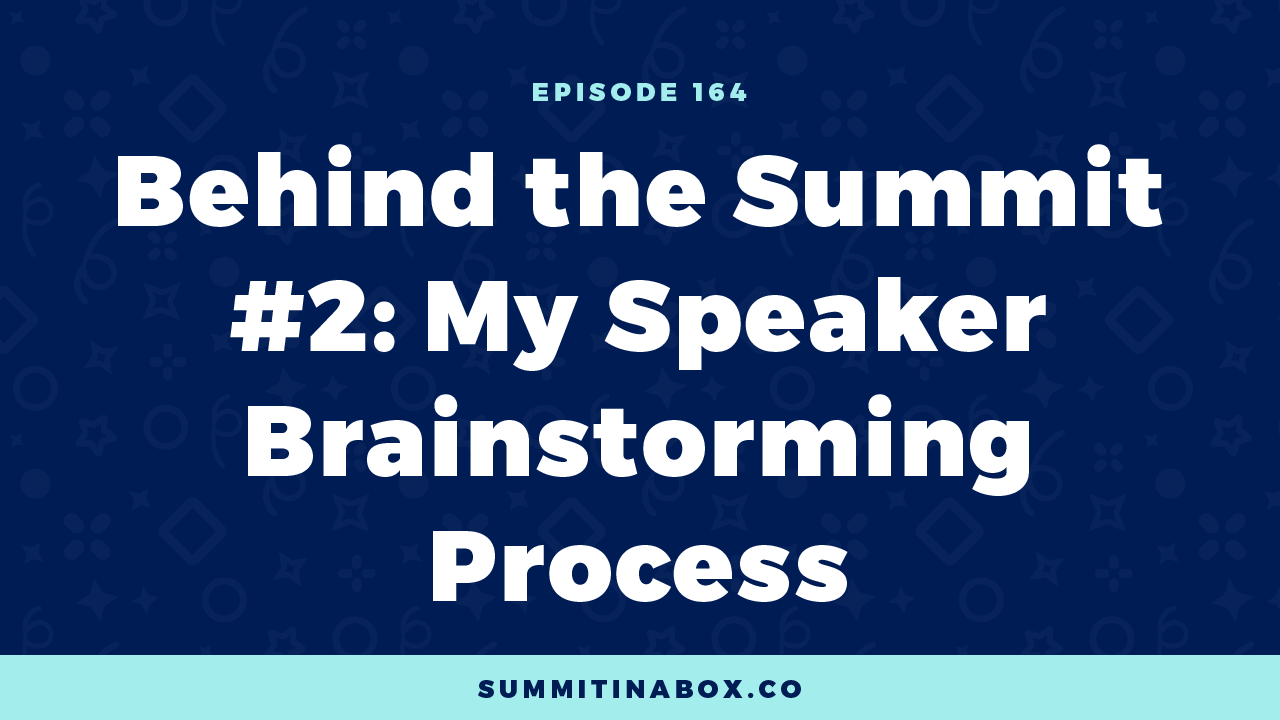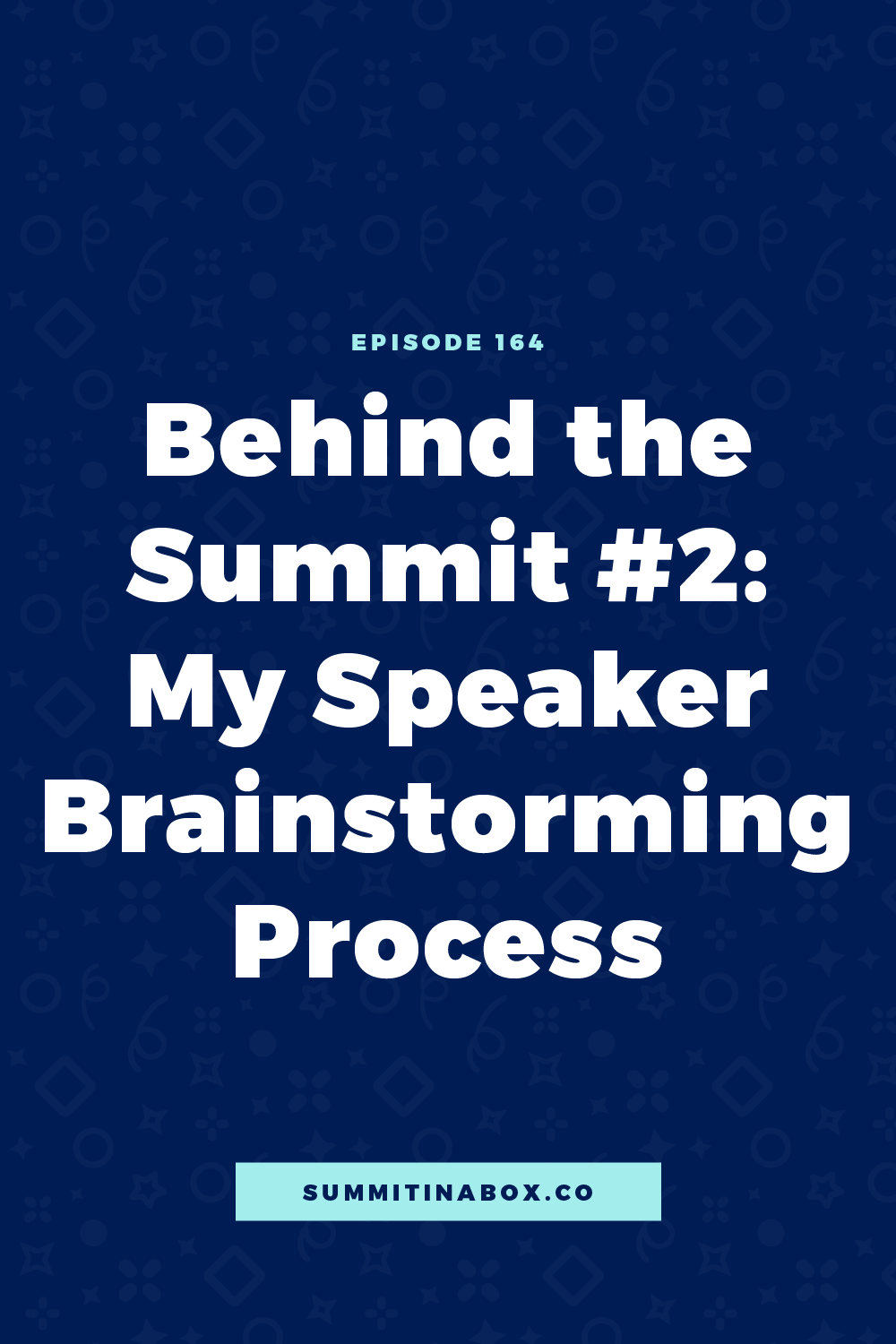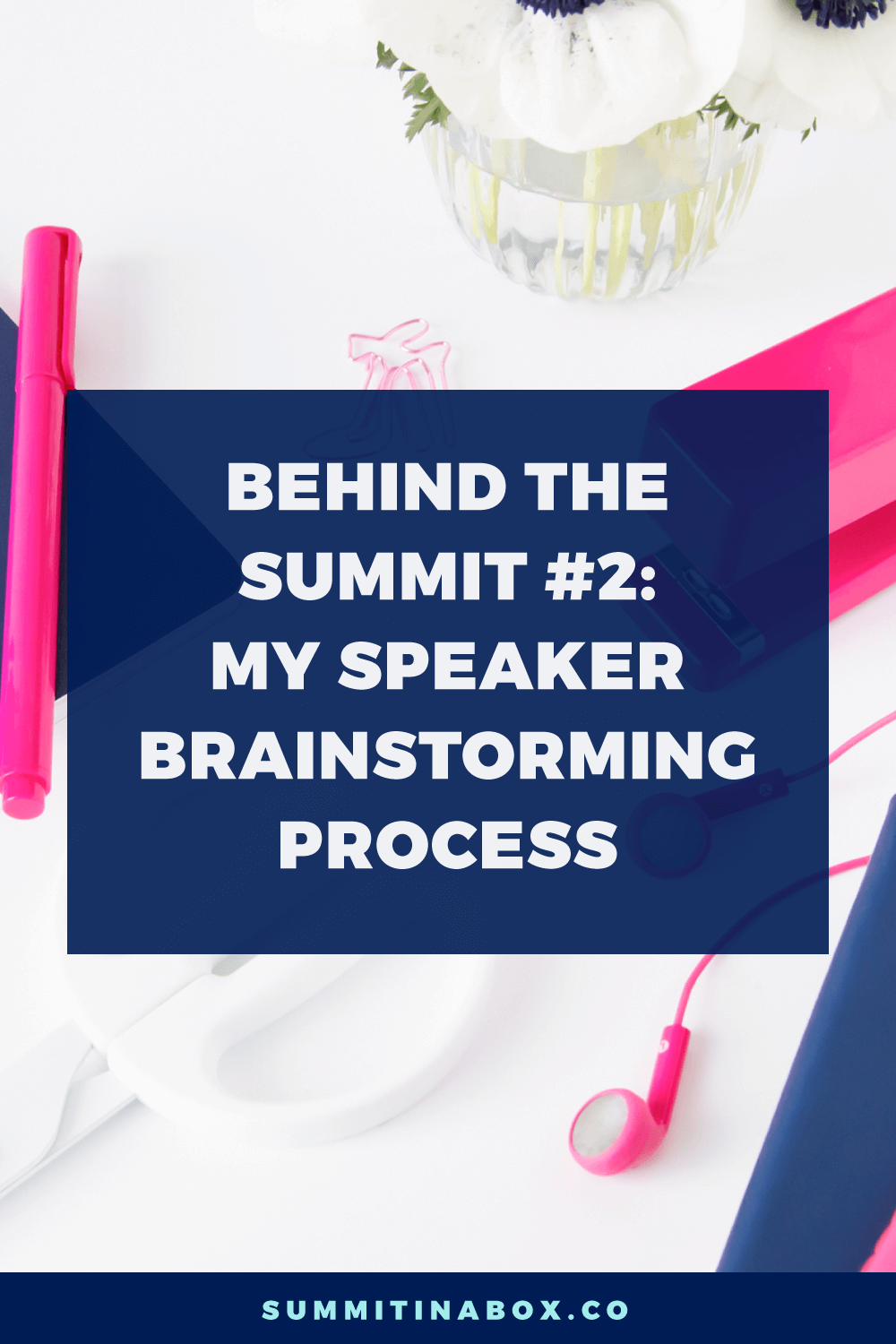Behind the Summit #2: My Speaker Brainstorming Process


When it’s time to pitch your summit speakers, which approach do you take?
Do you…
- Send your pitches on the fly as potential speakers come to mind?
- Pitch the people you know will say yes and let that determine your speaker line up?
- Strategically plan who to pitch based on the topics you want to cover and the transformation you want to create through your summit?
If you chose 3, congratulations! You’re way ahead of where I was when I hosted my first summit.
In all honesty, I put zero strategy into my process of finding and pitching speakers the first time around. I fell somewhere between options 1 and 2, pitching whoever came to mind, with a heavy bias towards people I thought would say yes.
It worked out ok in the end, but I missed out on several important aspects that I’ve incorporated into my summit strategy since.
A Look At The Big Picture
This week, I'll break down my full process of going from a totally blank speaker spreadsheet to having way too many options, and then narrowing that down to my initial list of people that I'm going to pitch.
I always underestimate how much time it's going to take, and it took about 10-15 hours this year.
I didn't always pay this much attention to the process, but my results speak for themselves. The first year of my summit, I hardly paid attention to it and made $16,000. But my most recent one brought in $92,000 and the biggest difference was being intentional about who I pitch.
Let's break this process down.
Stage 1: Speaker Brainstorming
The initial speaker brainstorming is a massive part of the process. In the past, I’ve used Airtable, sticky notes, or a combination of the two to organize my thoughts. This year, I used Board View in an Asana project.
I ended up with two projects in Asana:
- The first project was where I brainstormed speaker ideas. If I found someone I thought could be a good fit, I added them. Then, I sorted them by where I got the idea from, such as past speakers, Instagram searches, and audience suggestions.
- The second version of this was more organized and based on my presentation categories.
Consider Previous Speakers
I started my search with looking at my most recent summit’s top-performing speakers. I had 39 speakers and 35 had earned an affiliate income that ranged from $60 to $7100. I grabbed anyone who made over $1000 in affiliate income, which gave me 13 people to start with.
The benefit of starting with those people is that:
- They got their presentations in on time
- They were involved and showed up during the summit
- Attendees loved their presentations
- They promoted
In my speaker brainstorm list, I also included:
- 2 past speakers who asked to be a part of it again, even though they were under that $1000 threshold that I had originally looked at.
- A few people who reached out over the last year to be a part of it.
My Previous Speaker Brainstorm List
The next column in my Asana project was where I put the list of people from last year that I didn’t end up pitching or who weren’t able to participate. I also added anyone who I had flagged last year as being a good option.
That was great! That means every year this big process pays off again because you can go back and look at people you didn’t pitch and have a good starting place.
Time To Ask My Audience
From there, I sent out a quick survey to my email list and also put up a question box on Instagram. I got 15 more awesome ideas from that!
The reason I made this a separate column in my project was that now when I pitch these people, I could tell them that my audience wanted to learn from them.
I also had Kate look at last year’s attendee survey and pull possible speaker names and topics from their suggestions.
Social Media Deep Dive
Next, I did keyword searches on Instagram. I searched for anyone with “for designers” in their bio or their name. I found a ton of options by doing that!
58 potential speakers
I ended up with 58 potential speakers to filter through. Yay!
If I would have still needed more, I'd have shifted to searching for gaps in my presentations topics and then found speakers based on that.
I also want to point out that it’s completely normal to get some uncomfortable feelings during this stage. As I was looking through websites, I was doubting whether they’d want to be in the summit or work with me.
Stage 2: Find Topic Ideas
At this point, I had an unorganized and overwhelming list of 58 people and now it was time to put them into the context of the summit. I had to ask myself:
- Do they fit the event?
- What can they speak about?
I think two things are important when it comes to speakers and topics. It's important that...
- You pitch each speaker a specific topic.
- The topic you pitched them is related to something they’re already talking about and have offers around.
For all 58 people, I went to each website and looked at their social media, freebies, and paid offers to determine what topic to pitch them. It’s not a fast process, but it gave me a lot of great topic ideas.
In each person’s card in my Asana project, I put potential speaking topics in the description. Some people had only 1 or 2 topics ideas and some had as many as 10.
I didn’t filter through topic ideas at this point but gathered all the information that I could.
Stage 3: Narrow Down Topic Ideas
Next, I began to narrow down those topic ideas. I looked for topics that I definitely wanted to be covered in the summit, as well as unique topics for each speaker that fits in the context of the summit. So I went through all 58 speakers again and picked the top 1 or 2 topics for each person.
Behind their name in the Asana card, I included those top topic ideas I’d picked. I also used the “tag” function to tag people I for sure did or did not want to pitch. I didn’t remove anyone from the board, even if I didn’t plan to pitch them, because they might be a great fit for another year.
For me, this was a quick way to get an overview of what I needed to see about each speaker.
Stage 4: Identify Presentation Categories
Next, I changed gears a bit and worked to identify presentation categories.
Last year, I felt like I lost sight of what my summit’s goal was. My event is supposed to focus on helping designers simplify their business so they can profit more, have more free time, spend more time on design or other things important to them. Instead, I ended up with all of the popular topics for designers.
This year, I refocused on my event’s mission to do that. This helped me come up with my presentation categories. Now, you can share those categories with your audience or you can keep them to yourself for organizational purposes. I typically try to use one presentation category as each day’s topic, but don't force it if things won't line up.
The categories I ended up with are:
- Simplify Your Business
- Simplify Your Client Process
- Simplify Your Design Process
- Simplify Your Marketing
- Just For Fun
I also decided to try a rerelease of a series called “Let’s Do Better” which has presentations related to diversity, inclusivity, and eco-friendly design. I may release those pre-summit even so I’ll reach out to those speakers to ask if they’re okay with that.
Stage 5: Narrow Down Speaker Options
Now that I'd brainstormed speakers, narrowed down some topic options, and identified my presentation categories, I was ready to narrow down my 58 potential speakers. I hoped to land between 30-40.
Time For A New Asana Project
I decided to start yet another new Asana project to cut down on the overwhelm from the first two. I made a new board and each column was based on each category I had just come up with. Then, I moved each speaker one by one over to the new project.
If they had multiple possible topics, they got put under each category with their corresponding topic. That did mean they were listed on my board more than once. Some speakers ended up not a good fit based on the categories and didn’t make the move to the new board.
This process left me with 88 topic ideas on the board! But now I could see everything coming together and all the negative, imposter-syndrome feelings started to go away.
Stage 6: Organize and Narrow Down More
And finally, I got to the final stage where I begin to slowly organize all of the topic ideas and continue to narrow them down until I got to my final list of people to start with. This is a process I repeated over and over and over and got pickier and pickier each time.
First, if there was anyone I definitely wanted to pitch for a specific topic, I moved them to the top of the list. If there were any I knew I did not want, I checked them off, but kept the card visible, and moved them to the bottom of the list.
From there, I scrolled over and over and prioritized the rest of the names. I got pickier about who I kept and what they spoke on. I kept diversity in mind and prioritized people who were not the typical female, white voices that tend to fill summit lineups in this niche.
This left me with 38 people to pitch, and I was happy with this number.
If you’re hosting a first-time summit, I do not recommend you have that many speakers.
Stage 7: Prepare to Pitch Speakers
From there, it was just about time to pitch. However, I didn't want to keep track of the pitch process in my Asana project so my assistant, Kate, is going through and adding each person, their website, contact information, and speaking topic into our Outreach table in the summit Airtable Base. Tracking will be much easier from there.
If you’re a Summit In A Box® student, you have our Speaker Tracking Spreadsheet and the Outreach table is in that base.
I’m Ready to Pitch Speakers
Now that I’m ready to pitch speakers, I’ll start with past speakers, because they’re the easiest ones. To get ready for that, I need to update my...
- Pitch template
- Speaker information page
- Speaker guidelines
- Speaker checklists
- Registration page
More on that next week!
Make It Your Own
This was a long process! I always forget how long it takes, but I promise that the results are worth being diligent about finding the right speakers.
Decide what this process could look like for you and schedule in much more time than you think you’ll need to make your pitches.
Resources
- Episode 18: How To Host A Diverse & Inclusive Virtual Summit with Nichole Beiner
- Episode 21: Having Happy And Engaged Summit Speakers
- Episode 69: The Problem With Requiring Speaker Promotion + How To Do It Right
- Episode 99: 4 Reasons Speakers Say "Yes" When You Pitch Them for Your Virtual Summit
- Summit Host Hangout Facebook group
Pin it for later!




